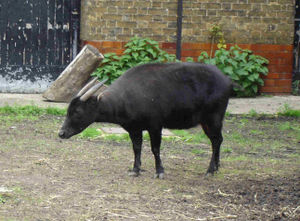Bubalus
Bubalus is a genus of Bovidae, a family that includes domestic cattle, bison, African buffalo, the water buffalo, and other species of wild cattle. Members of the genus Bubalus are commonly known as buffaloes, with the most notable species being the Asian water buffalo (Bubalus bubalis) and the Tamaraw (Bubalus mindorensis), which is found only in the Philippines. These large herbivores play a crucial role in their ecosystems and have significant economic and cultural importance in many parts of Asia.
Description[edit | edit source]
Members of the genus Bubalus are characterized by their large size, heavy build, and distinctive horns that can span over 2 meters in the case of the Asian water buffalo. They have a broad, heavy skull and a relatively short, thick neck. Their body is covered with coarse hair, which can vary in color from light grey to black. These animals are well adapted to a variety of habitats, from wetlands to forests, and are known for their ability to thrive in both wild and domesticated environments.
Species[edit | edit source]
The genus Bubalus includes several species, among which the most well-known are:
- Bubalus bubalis (Asian water buffalo) - This species is domesticated in many parts of Asia and used for draught, meat, and milk production. It is also present in a wild form in some regions.
- Bubalus mindorensis (Tamaraw) - A critically endangered species found only on the island of Mindoro in the Philippines. It is smaller and more solitary than its cousins.
- Bubalus depressicornis (Lowland Anoa) - A small buffalo found in the forests of Sulawesi, Indonesia.
- Bubalus quarlesi (Mountain Anoa) - Another species of small buffalo from the mountainous regions of Sulawesi.
Habitat and Distribution[edit | edit source]
Bubalus species are found in a wide range of habitats across Asia, from the wetlands and floodplains of India and Southeast Asia to the forests of the Philippines and Indonesia. The Asian water buffalo is the most widespread species, having been domesticated thousands of years ago and introduced to many parts of the world, including Europe, Africa, the Americas, and Australia.
Conservation[edit | edit source]
The conservation status of Bubalus species varies significantly. While the domesticated Asian water buffalo is numerous, wild populations are considered vulnerable due to habitat loss, hunting, and interbreeding with domestic animals. The Tamaraw is critically endangered, with only a few hundred individuals remaining, due to habitat destruction and poaching. Conservation efforts for these species include habitat protection, anti-poaching measures, and breeding programs to increase population sizes.
Cultural Significance[edit | edit source]
In many cultures across Asia, the buffalo is an important symbol of life and fertility. It is integral to agricultural practices and ceremonies and features prominently in folklore and mythology. The buffalo is revered in some cultures and is often associated with strength, perseverance, and hard work.
Search WikiMD
Ad.Tired of being Overweight? Try W8MD's physician weight loss program.
Semaglutide (Ozempic / Wegovy and Tirzepatide (Mounjaro / Zepbound) available.
Advertise on WikiMD
|
WikiMD's Wellness Encyclopedia |
| Let Food Be Thy Medicine Medicine Thy Food - Hippocrates |
Translate this page: - East Asian
中文,
日本,
한국어,
South Asian
हिन्दी,
தமிழ்,
తెలుగు,
Urdu,
ಕನ್ನಡ,
Southeast Asian
Indonesian,
Vietnamese,
Thai,
မြန်မာဘာသာ,
বাংলা
European
español,
Deutsch,
français,
Greek,
português do Brasil,
polski,
română,
русский,
Nederlands,
norsk,
svenska,
suomi,
Italian
Middle Eastern & African
عربى,
Turkish,
Persian,
Hebrew,
Afrikaans,
isiZulu,
Kiswahili,
Other
Bulgarian,
Hungarian,
Czech,
Swedish,
മലയാളം,
मराठी,
ਪੰਜਾਬੀ,
ગુજરાતી,
Portuguese,
Ukrainian
Medical Disclaimer: WikiMD is not a substitute for professional medical advice. The information on WikiMD is provided as an information resource only, may be incorrect, outdated or misleading, and is not to be used or relied on for any diagnostic or treatment purposes. Please consult your health care provider before making any healthcare decisions or for guidance about a specific medical condition. WikiMD expressly disclaims responsibility, and shall have no liability, for any damages, loss, injury, or liability whatsoever suffered as a result of your reliance on the information contained in this site. By visiting this site you agree to the foregoing terms and conditions, which may from time to time be changed or supplemented by WikiMD. If you do not agree to the foregoing terms and conditions, you should not enter or use this site. See full disclaimer.
Credits:Most images are courtesy of Wikimedia commons, and templates Wikipedia, licensed under CC BY SA or similar.
Contributors: Prab R. Tumpati, MD





